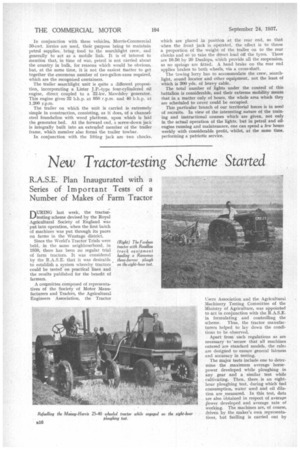New Tractor-testing Scheme Started
Page 50

Page 51

If you've noticed an error in this article please click here to report it so we can fix it.
R.A.S.E. Plan Inaugurated with a Series of Important Tests of a Number of Makes of Farm Tractor DURING last week, the tractor: testing scheme devised by the Royal Agricultural Society of England was put into operation, when the first batch of machines was put through its paces on farms in the \Vantage district.
Since the World's Tractor Trials were held, in the same neighbourhood, in 1930, there has been no regular trial of farm tractors. It was considered by the R.A.S.E. that it was desirable to establish a system whereby tractors could be tested on practical lines and the results published for the benefit of farmers.
A committee composed of representatives of the Society of Motor Manufacturers and Traders, the Agricultural Engineers Association, the Tractor Users Association and the Agricultural Machinery Testing Committee of the Ministry of Agriculture, was appointed to act in conjunction with the R.A.S.E. in formulating and controlling the scheme. Thus, the tractor manufacturers helped to lay down the conditions to be observed.
Apart from such regulations as arc necessary to 'secure that all machines entered are standard models, the rules are designed to ensure general fairness and accuracy in testing.
The major tests include one to determine the maximum average horsepower developed while ploughing in any gear and a similar test while cultivating. Then, there is an eighthour ploughing test, during which fuel consumption, water used and oil dilution are ,measured. In this test, data are also obtained in respect of average power developed and average rate of working. The machines are, of course, driven by the maker's own representatives, but fuelling is carried out by officials and all tanks are under seal during the run.
For determining maximum drawbar 'pulls, a recording dynamometer, carried on a platform at the rear of the tractor, is .employed. During the eight-hour tests, a direct-reading instrument is coupled between the tractor and plough, and is kept under visual observation by the officials in charge.
The ground on which this series of autumn tests has been conducted consists of a section on heavy clay and a section of light land. There will, accordingly, be two sets of figures available for the two classes of land. Ploughs used in most cases were supplied by Ransomes, Sims and Jeffries, Ltd., but the Massey-Harris and International Harvester concerns employed ploughs of their "own manufacture behind their tractors.
The machines tested were the Bristol ; John Deere • BR; Fordson Utility ; Fordson Agricultural ; Fordson Roadless ; Case Roadless ; Caterpillar RD4; International TD35 ; MasseyHarris 25-40; and Massey-Harris Pacemaker. A further batch of machines is to be tested in the spring of next year.
Of the machines listed above, which were selected from about 17 entered, the Bristol and Fordson are the only two manufactured in this country. Two, the Caterpillar and the International, are equipped with oil engines and are of the crawler type. The Bristol, Fordson Roadless and Case Roadless are mounted on the Roadless Traction Co.'s tracks.
The feature of these tests, as distinct from those conducted at Nebraska and elsewhere, is that the machines have to perform entirely under farming conditions. Although every effort is made by the officials to enable entrants to attain their best performance, it is likely, that in the case of some machines, the conditions of test may result in lower power outputs being recorded than in other tests.
This particularly applies to maximum drawbar pulls, which are taken in these tests while ploughing is going on and are averaged over the whole length of furrow. An oil-engined tractor which can get away under full load performs relatively well in such a test, compared with any machine employing light fuel in a fairly highspeed power unit.
Such machines do better in a test where they are allowed to start under comparatively low load and build up to a maximum, which is read for reCording.
The figures obtained should, therefore, be a reliable guide to makers and buyers • regarding the performance which may be expected under actual farm conditions.




























































































